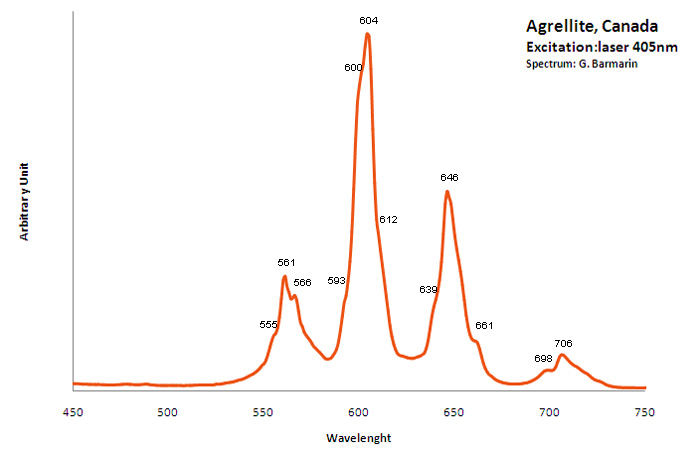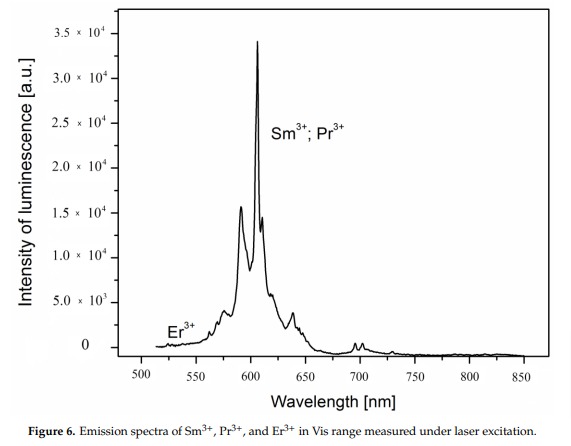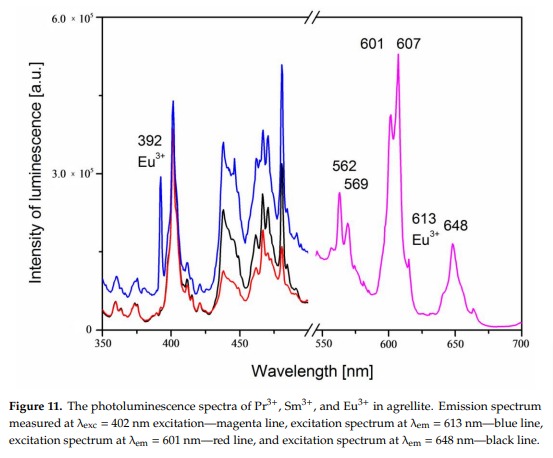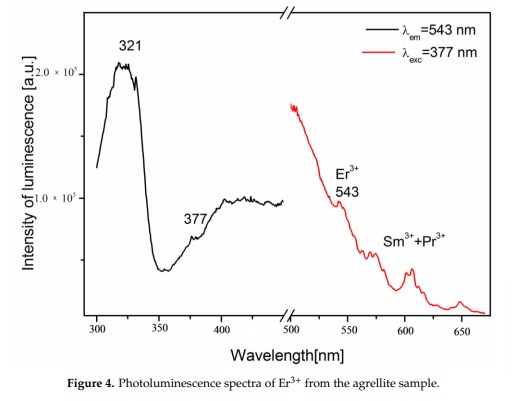Database of luminescent minerals
AGRELLITE
Chemical formula: NaCa2Si4O10F
Family: Silicates
Status: IMA-A
Crystal system : Triclinic
Display mineral: OUI
Luminescence:
Longwave UV (365nm) colors: |
Pink , | ||
Intensity LW:Very weak | |||
Midwave UV (320nm) colors: |
Violet Pink , | ||
Intensity MW:Strong | |||
Shortwave UV (254nm) colors: |
Violet Pink , | ||
Intensity SW:Medium | Frequency SW:Always | ||
Daylight picture

AGRELLITE, Kipawa River, Quebec, Canada;
Photo and Copyright: James Hamblen
Site of the author
Used with permission of the author
Shortwave (254nm) picture

AGRELLITE, Kipawa River, Quebec, Canada;
OC (254 nm).
Photo and Copyright: James Hamblen
Site of the author
Used with permission of the author
Do you have a photo of this mineral you would like to see in the gallery? Contact us!
Phosphorescence (in the common sense of the term) observable with the naked eye:
Type d'UV |
Couleur |
Intensité |
Fréquence d'observation |
|---|---|---|---|
UV longs (365nm): | None by naked eye | UV moyens (320 nm): | None by naked eye | UV courts (254 nm): | Yellowish White | Medium |
Comments:
Sometimes associated with : hyalite (fluo green SW), VLASOVITE (fluo yellow-orange SW), feldspath (fluo red SW), red eudyalite and brown mosandrite; Some SW 4 color specimens from the Darai-Pioz Glacier, Tajikistan. have white fluorescing Baratovite, Pink fluorescing Agrellite, Magenta fluorescing Microcline, and an unknown fluorescing Green (hyalite?).
Activator(s) and spectrum:
Activator(s): Mn2+ , Fe3+, Eu2+, Ce3+, Sm3+, Dy3+, Nd3+, Gd3+,
Peaks in the spectrum (nm):
Mn2+ replacing Ca2+: Large band peaking at 580nm
Eu2+: 410nm
Sm3+: 560, 597, 602, 640nm
Dy3+: 475, 485, 580nm
Fe3+ replacing Si4+: 740nm
Nd3+(?): 955nm
Ref. sample: (555), (561), 566, (593), (600), 604, (612), (639), 646, 661, 698 and 706 nm

Agrellite, Canada. Excitation: laser 405nm. Col. G. Barmarin; Spectre: G. Barmarin
Spectrum Galery:



 ...
...Comments on spectrum and activators:
A brief but distinctive orange flash is seen before the magenta luminescence (typical of Mn activator?). There is sometime a green fluorescent mineral accompagning agrellite. It is sometime reported as thorium activated calcite (???) that will glow green sw and mw whitish green lw and will phos under all 3 waves. Sometime thorite coating are invoqued to explain the green fluorescence in specimens from Kipawa. Albite fluorescing red SW is also often present. The emission centers observed in agrellite samples vary depending on their geographical origin. Here is a summary of the findings: Kipawa River Samples: Yakutia Samples: Dara-i-Pioz Samples: Additionally, recent spectroscopic investigations of agrellite samples from Dara-i-Pioz (Tajikistan) and Murun massif (Russia) have shown luminescence from Ce³⁺ and EPR spectra of Mn²⁺. However, it is noted that some expected emissions were not observed in certain samples. For instance, the luminescence of Mn²⁺ and Eu²⁺ was not observed in some specimens
RE elements (RRE2+ and RRE3+) replacing Ca2+ are suspected as activators. Also Mn and Fe.
Fluorescence: pink LW after Robbins and other authors, clearly visible with pointer-laser @405nm.
As with other minerals activated by RRE, the shape of the spectrum is strongly influenced by the resolution of the spectrometer because RRE have a lot of very narrow peaks very close from each other. If the resolution of the spectrometer is not sufficient, the pikes are agglomerated in larger entities.
Best localities for fluorescence (*):
- Mt Kipawa Complex, Kipawa River, Sheffield Lake, Villedieu Township, Québec, Canada;
- Darai-Pioz (Dara-i-Pioz) Glacier, Alai (Alayskiy) Range, Tien Shan Mts, Region of Republican Subordination, Tajikistan;
- Kedrovyi alkaline Massif, Murunskii Massif, Chara and Tokko Rivers Confluence, Aldan Shield, Sakha Republic (Yakutia), Eastern-Siberian Region, Russia;
- Wausau Complex in Marathon County, Wisconsin, USA
(*)The data are not exhaustive and are limited to a few remarkable localities for fluorescence
Bibliographic reference for luminescence:
- The Henkel Glossary of Fluorescent Minerals, Dr. Gerhard Henkel, Published by the FMS, 1989 ,
- Fluorescence: Gems and Minerals Under Ultraviolet Light, Manuel Robbins, 1994, Geoscience Press, ISBN 0-945005-13-X ,
- The World of Fluorescent Minerals, Stuart Schneider, Schiffer Publishing, 2006, ISBN 0-7643-2544-2 ,
- Luminescence Spectroscopy of Minerals and Materials, M. Gaft, R. Reisfeld, G. Panczer, Springer Editor, ISBN: 10 3-540-21918-8 ,
- Luminescent Spectra of Minerals, Boris S. Gorobets and Alexandre A. Rogojine, Moscow, 2002 ,
- Luminescenza nel regno minerale, Guido Mazzoleni, fotografia Roberto Appiani, Libri Sandit, 2010, ISBN 978-88-95990-63-7 ,
Reference for luminescence on the Internet:
- http://www.turnstone.ca/rom94soa.htm
- https://www.mindat.org/min-57.html
- http://www.handbookofmineralogy.com/pdfs/agrellite.pdf
- Luminescence of Agrellite Specimen from the Kipawa, River Locality, Maria Czaja and Radosław Lisiecki
- UV Waves January/February 1996
- Projet Terres Rares au Québec
- Geonieuws January 2010
- Agrellite fluorescence by Bob Fosbury on Flickr and https://www.flickr.com/photos/bob_81667/6694411183/
Images:
- Kipawa, Canada, SW: https://www.mindat.org/photo-75962.html
- Kipawa, Canada, SW: https://www.mindat.org/photo-602666.html
- Kipawa, Canada, LW: https://www.mindat.org/photo-666389.html
Videos:
- On Nature Rainbows or on Youtube (same)
Mineralogical reference on the Internet:
 http://www.mindat.org/show.php?name=Agrellite
http://www.mindat.org/show.php?name=Agrellite
 http://webmineral.com/data/Agrellite.shtml
http://webmineral.com/data/Agrellite.shtml
Internet Search:
 Image search on 'Google Images'
Image search on 'Google Images'
 Search for documents in all languages on Google
Search for documents in all languages on Google
A request providing no result means only that no such reference exists in the database, but it does not mean that what you are looking for does not exist, just not to our knowledge. If you think you have found an error or omission, please let us know via the contact page being sure to cite the source of information.

